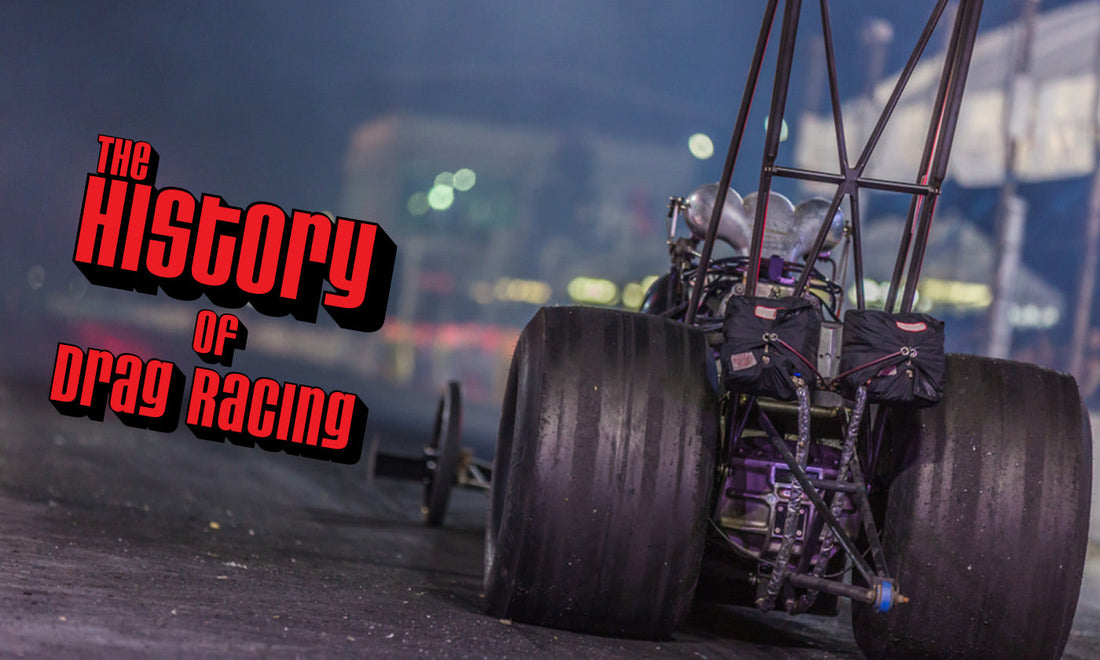Ever since the first car was invented, drivers have been obsessed with speed. Their obsession with going fast has led to each generation of cars being faster, with better handling, and better acceleration. But, how did this desire for speed turn into drag racing — one of the most popular and beloved sports in the United States?
The Birth of Drag Racing
Drag racing as you have come to know today came into being after decades of experimentation, and it all started in the dry lake beds of the California desert. Throughout the early and mid 20th century, certain people considered racing taboo. It was looked down upon and frowned on in general. Like many great sports and games of this generation, it all began underground.
After the 1930s, engines started getting a lot louder, a lot bigger, and a lot faster, while drivers were getting a lot more ambitious and fearless. Speeds for cars started reaching over 100 mph and more people were getting access to cars. But it wasn’t until after the Second World War that drag racing really kicked into gear.
After the war, some kids with nothing to do and nowhere to be had both the worst and the best idea ever. What started as a one-time thing, slowly grew in popularity but remained an underground past time for many years. In the 1940s and 1950s, young adults would gather at unused military runways to indulge in some clandestine racing. There are some sources that indicate that the first-ever drag race took place in 1949.
The entire experience of drag racing before it was an organized sport was very fresh and raw. Featuring massive, low tech machines facing off one-on-one on a short track with no barriers or guidelines, it was the start of something very special. The audience enjoyed these races the most, as there were no conventional seating arrangements hundreds of feet away from the car. At every race, the audience members were often only a few feet away from cars zipping right past them at full speed.

Organized drag racing
As the 50s rolled in, soon came the time of organized drag racing.
As the popularity for drag racing soared, it became too big to ignore. The National Hot Rod Association (NHRA) came into being in 1951 and by the 60s, two varied classes of the competition were developed: unmodified stock and top eliminator. The NHRA, founded by Wally Parks, soon paved the way for the sport to gain immense traction at a level never seen before.
With the sport growing, superstars emerged and with them, their cars of choice. Every racing fanatic wanted to be the next Leonard Harris or Dode Martin. And fans longed to race the Albertson Olds and the Dragmaster Dart, two of the best drag race cars of their time. There were not only fans who were swooning over these cars; the Dragmaster Dart was so famous that other drivers used it as a template for their own cars.
The 60s saw more technological changes come onto the track. The traditional race starter — the person holding two flags between the cars — was replaced by an electronic lighting system. Fun fact: this was the first example of automation in sports! The 1960s also saw a drastic shift in the shape of the cars — going from wide and small, to thin and long. During this time, the World Series of Drag Racing was also created as one of the many organizations for the sport.

The involvement of big businesses
Until the 1960s, no major car manufacturing company invested in drag racing. But with the close of the decade, major car companies like Ford and Chrysler not only invested in the sport itself, but also got into a rivalry of sorts.
These companies battled it out to see who could get the better car out; each car being radically different from the others in terms of design and shape. Some companies also started making "funny cars", which were cars without doors. To enter these cars, drivers would have to lift the car and make their way inside. Ironically, despite its name, the car was quite effective in drag racing, and many people preferred it to the other drag racing cars of the time.
Thanks to the involvement of big businesses like Ford and Chrysler, competition in the drag race scene was rampant, and people were trying to outdo each other. This lead to what many consider to be the drag race renaissance in the 70s, where various companies were manufacturing cars that were great for drag racing. Following a serious accident, many changes took place that became staples of the genre.

A major accident
In March of 1970, drag racer by the name Don Garlits (considered by many to be the father of drag racing) found himself in a terrifying situation. His front-engined slingshot rail dragster suffered from a transmission explosion which cut the car in half and cost him his right foot. Although he survived, he vowed to make a race car as powerful as the one that had exploded, but with an engine at the back. Not only did he succeed in making the car, but the car was also able to win a championship, to many people's surprise.
Fast forward to two years later, and almost every major drag race car manufacturer was now making cars with engines behind the driver.

The drag race renaissance
Drag racing experienced a renaissance during the 1970s, a time when all major car manufacturers were participating in drag races around the world, and different companies started investing in it. Teams were paid for their services, trailers were turned into mobile workshops, and prize money got a whole lot bigger. The fundamentals of drag racing remain the same even today, and anyone who has done it or witnessed it knows what a whiteknuckle moment is!

